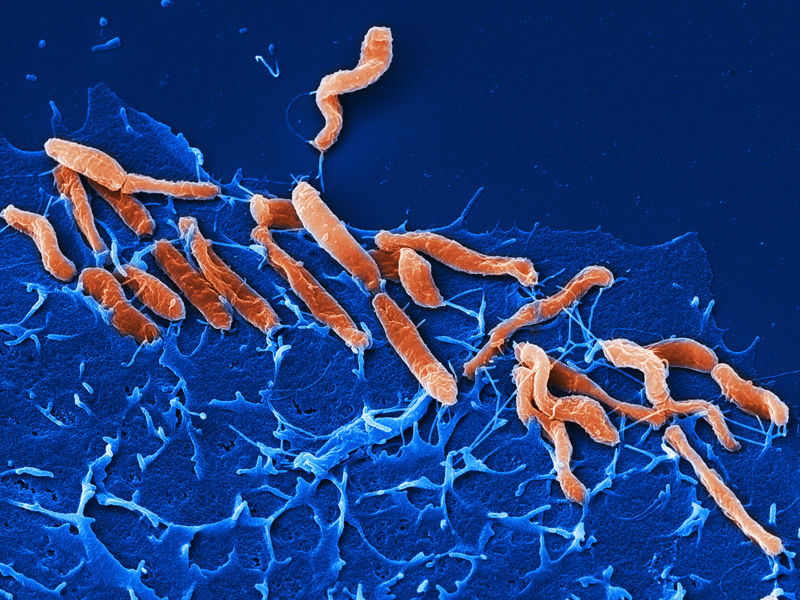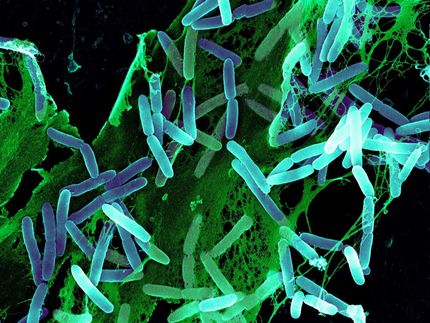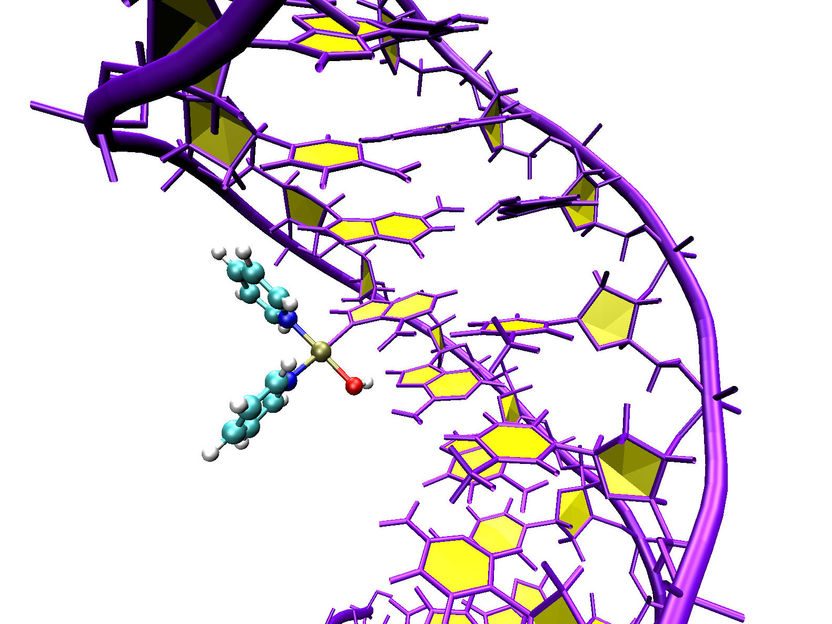A dangerous bond
New receptors discovered for stomach germ Helicobacter pylori
Helicobacter pylori is a bacterium that can colonize the human stomach – sometimes with fatal consequences. A research group led by Prof. Markus Gerhard of the Technical University of Munich (TUM) and Assistant Professor Dr. Bernhard B. Singer of the Institute for Anatomy at the Faculty of Medicine of the University of Duisburg-Essen has discovered a completely new approach to preventing or treating infections with this bacterium as well as secondary complications.

Helicobacter pylori infection increases the risk of developing stomach cancer.
M. Rohde/HZI
Helicobacter pylori infection usually occurs during childhood. The bacterium is widely spread: every third person in Germany and every other person worldwide is a carrier. Secondary complications include gastritis, stomach and duodenal ulcers. In addition, there is an increased risk of developing stomach cancer. The typical treatment for Helicobacter pylori infections is currently antibiotics. The disadvantage of this treatment, however, is that it not only destroys the bacterium itself but also the ‘good germs’ of the gut flora. In addition, the bacterium is developing increasing resistance.
In order to ensure permanent survival in the human stomach, Helicobacter pylori must attach to the epithelial cells in the gastric mucosa. Research groups in Munich, Essen, and Brussels have now detected a highly specific and exceptionally strong variant of this adhesion, in which the bacterial surface molecule HopQ binds itself to so-called “Carcinoembryonic Antigen-Related Cell Adhesion Molecules”, or CEACAMs for short, inside the stomach.
Independent of sugar
“In contrast to previously known binding partners of the bacterium, this bond is independent of sugar structures. This seems to ensure that it is especially stable in the acid environment of the stomach,” explains Bernhard B. Singer. CEACAMs do not occur in healthy stomach tissue, but primarily when there is an inflammation of the gastric mucosa (gastritis) caused by Helicobacter pylori infection.
“One could say that these germs create additional and particularly strong binding opportunities by stimulating the formation of CEACAMs,” adds Singer. Once bound to CEACAM, Helicobacter pylori can transfer additional proteins, so-called virulence factors, to the stomach cells. This secretion system contributes significantly to the development of stomach ulcers and bowel cancer. “Against this backdrop, we assume that HopQ could be used diagnostically and therapeutically,” says Markus Gerhard, Professor at the Institute for Medical Microbiology, Immunology and Hygiene at TUM.
New approaches to treatment
The Scientists are currently researching various approaches in order to replace current types of treatment for Helicobacter pylori infection, due to the aforementioned side effects. The adhesion of the bacterium to stomach cells could be prevented with a soluble version of HopQ or parts of the protein, and the damaging effects of the germ could potentially be suppressed, as the data in the publication indicate. As a further therapeutic option, the researchers are pursuing the approach of using specifically developed antibodies against CEACAMs in order to fight diseases associated with the bacterium. An additional treatment option being considered is immunization against the HopQ protein and thus vaccination against infection with the bacterium.
Original publication
A. Javaheri , T. Kruse, K. Moonens, R. Mejías-Luque , A. Debraekeleer, I. Asche, N. Tegtmeyer, B. Kalali , N.C. Bach, S.A. Sieber, D.J. Hill, V. Königer, C.R. Hauck, R. Moskalenko, R. Haas, D.H. Busch, E. Klaile , H. Slevogt, A. Schmidt, S. Backert, H. Remaut, B.B.Singer, M. Gerhard M.; "Helicobacter pylori adhesin HopQ engages in a virulence-enhancing interaction with human CEACAMs"; Nature Microbiology; 2016
Original publication
A. Javaheri , T. Kruse, K. Moonens, R. Mejías-Luque , A. Debraekeleer, I. Asche, N. Tegtmeyer, B. Kalali , N.C. Bach, S.A. Sieber, D.J. Hill, V. Königer, C.R. Hauck, R. Moskalenko, R. Haas, D.H. Busch, E. Klaile , H. Slevogt, A. Schmidt, S. Backert, H. Remaut, B.B.Singer, M. Gerhard M.; "Helicobacter pylori adhesin HopQ engages in a virulence-enhancing interaction with human CEACAMs"; Nature Microbiology; 2016
Organizations
Other news from the department science

Get the life science industry in your inbox
By submitting this form you agree that LUMITOS AG will send you the newsletter(s) selected above by email. Your data will not be passed on to third parties. Your data will be stored and processed in accordance with our data protection regulations. LUMITOS may contact you by email for the purpose of advertising or market and opinion surveys. You can revoke your consent at any time without giving reasons to LUMITOS AG, Ernst-Augustin-Str. 2, 12489 Berlin, Germany or by e-mail at revoke@lumitos.com with effect for the future. In addition, each email contains a link to unsubscribe from the corresponding newsletter.




















































